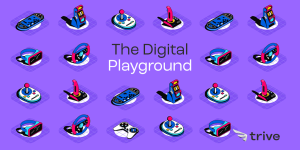Piece written by Mareike Kramper & Ayanda Sithole, Trive Copywriter
The world of artificial intelligence (AI) continues to evolve at a breathtaking pace, with new models and innovations constantly emerging. In the realm of AI-driven conversations, two names have been making waves: ChatGPT and Bard. In this blog post, we will explore the fascinating showdown between these two conversational AI giants, examining their origins, capabilities, and potential impacts on the future of human-AI interactions.
ChatGPT: The Prodigy from OpenAI
ChatGPT, developed by OpenAI, has earned its stripes as one of the most sophisticated conversational AI models in the world. It represents the culmination of years of research and development, leveraging the GPT-3.5 architecture with a staggering 175 billion parameters.
Key Features of ChatGPT:
- Natural Language Understanding: ChatGPT has an exceptional ability to understand and generate text in a coherent, human-like manner. It can converse on a wide range of topics, answer questions, and maintain context throughout a conversation.
- Contextual Awareness: This model remembers previous interactions and utilizes context to provide relevant responses. This capability enhances its effectiveness in complex and dynamic conversations.
- Multilingual Proficiency: ChatGPT boasts multilingual support, allowing it to communicate seamlessly in various languages, making it a versatile tool on a global scale.
Bard: The Rival Challenger
Bard, short for “Bidirectional Encoder Representations from Transformers with Deep Reinforcement Learning,” is a formidable competitor in the world of AI conversations. Developed by Google Research, it offers unique strengths that set it apart from its peers.
Key Features of Bard:
- Bi-Directional Capabilities: Bard is designed to understand the context of conversations better by considering both past and future parts of a text, allowing for a more nuanced and contextually aware conversation.
- Deep Reinforcement Learning: This model incorporates deep reinforcement learning techniques, enabling it to optimize its responses over time based on user feedback.
- Enhanced Controllability: Bard provides more precise control over the generated content, allowing users to specify the desired style, tone, and even the complexity of responses.
The Showdown: ChatGPT vs. Bard
While both ChatGPT and Bard are AI marvels, they have unique strengths that make them suitable for different applications. Here’s a comparative look at how they stack up against each other:
- Naturalness vs. Controllability: ChatGPT excels in generating natural and contextually relevant responses, making it a superb choice for interactive and dynamic conversations. On the other hand, Bard offers greater controllability, which is valuable for generating content with specific requirements, such as marketing copy.
- Contextual Awareness: ChatGPT boasts impressive contextual awareness, which allows it to excel in maintaining coherent conversations. Bard, with its bi-directional capabilities, also excels in understanding nuanced context, making it suitable for tasks that require deep comprehension.
- Multilingual Support: Both models offer multilingual capabilities, breaking language barriers effectively.
In the world of conversational AI, ChatGPT and Bard are two formidable competitors, each with its unique strengths and applications. ChatGPT’s naturalness and contextual awareness make it an excellent choice for interactive conversations, customer support, and educational applications. Meanwhile, Bard’s controllability and deep reinforcement learning make it a powerful tool for generating tailored content and understanding complex context. While Google Bard is already impressing users with its abilities, it’s important to note that it is still in development.
Ultimately, the choice between ChatGPT and Bard depends on the specific needs of the task at hand. As these models continue to evolve and mature, they promise to reshape the landscape of AI-driven conversations, bringing us closer to the day when humans and machines can converse effortlessly and intelligently, ushering in a new era of AI-powered communication.
This material is provided for informational purposes only and does not constitute financial, investment or other advice. Trive Financial Services Malta Limited does not offer shares in OpenAI, as it is not a publicly traded company. No opinion contained in this material constitutes a recommendation by Trive Financial Services Malta Limited or its author as to any particular investment, transaction or investment strategy and should not be relied upon in making any investment decision. In particular, the information does not take into account the individual investment objectives or financial circumstances of the individual investor. Trive Financial Services Malta Limited shall not be liable for any loss, damage or injury arising from the use of this information.


